June 21, 2019
Air Date: June 21, 2019
FULL SHOW
SEGMENTS
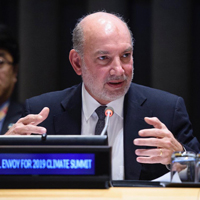
Increasing World Climate Ambition
View the page for this story
The United Nations is preparing for the Climate Summit this September, where many countries are expected to boost their Nationally Determined Contributions, or NDCs, under the Paris Climate Agreement. Luis Alfonso de Alba is the United Nations Secretary-General's Special Envoy on Climate Change, and he joins Host Steve Curwood to talk about concerns and hopes of keeping planetary warming from increasing more than 1.5 degrees centigrade. (06:02)
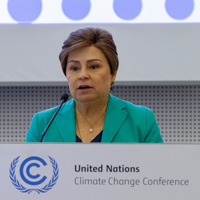
Moving the Paris Climate Deal Ahead
/ Aynsley O'NeillView the page for this story
2,000 delegates representing 185 countries gather in Bonn, Germany to refine rules and procedures for the Paris Climate Agreement, with an emphasis on boosting carbon reduction ambitions before the 2020 deadline. Living on Earth's Aynsley O'Neill has more. (05:06)
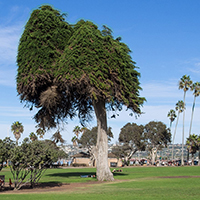
Beyond the Headlines
/ Peter DykstraView the page for this story
This week, Peter Dykstra and Steve Curwood dive beyond the headlines to note the fall of an iconic Monterey Cypress tree in San Diego, California, which was said to have inspired Dr. Seuss’s Truffula trees in “The Lorax”. Next they discuss the European far-right’s apparent shift away from climate denial, as climate-driven immigration hits home, and finally in the history calendar, it’s the 50th anniversary of the infamous Cuyahoga River fire, which helped prompt the passage of the Clean Water Act. (03:21)

Bringing Back Butternut Trees
View the page for this story
Butternut trees, also known as white walnuts, used to be abundant in the forests of the Northeast and the Midwest, but have now been devastated by a fungus. As the Allegheny Front’s Andy Kubis tells us, help for this struggling species may soon be at hand. Ecologists in Pittsburgh, Pennsylvania found a small group of healthy butternuts and are studying how these hardy trees resisted the fungus. (03:57)
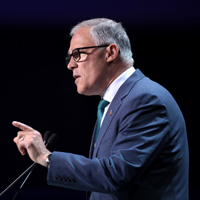
Rating the Climate Promises of 2020 Prexy Candidates
View the page for this story
Although climate wasn’t discussed much in the 2016 presidential election, this time around it’s turning out to be a much hotter topic. With over twenty Democratic candidates on the playing field, it can be hard to keep track of where they all stand on the climate crisis. So to sort it all out, Greenpeace put together a climate scorecard, grading each candidate on their commitment to a Green New Deal and to phasing out fossil fuels. There are a couple of standout candidates, but not a single presidential hopeful earned a Greenpeace A+. To hear about the scorecard, Host Steve Curwood speaks with Janet Redman, Climate Campaign Director for Greenpeace USA. (11:47)
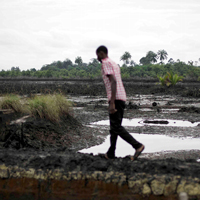
Seeking Justice for the Ogoni Nine
View the page for this story
Esther Kiobel is one step closer to justice in her battle against The Royal Dutch Shell Oil Company. She has pursued the oil giant for nearly 25 years, since the Nigerian government executed her husband in 1995 on trumped up charges, allegedly encouraged by Shell. Ms. Kiobel’s husband was part of a group known as the Ogoni Nine, which fought against Shell for environmental and economic damages brought to their homeland near the Niger River Delta. Now Ms. Kiobel, supported by Amnesty International, will finally have her case for reparations and the clearing of her husband’s name heard by a District Court in the Netherlands. Host Steve Curwood speaks with Amnesty’s Head of Business and Human Rights, Mark Dummett. (14:10)
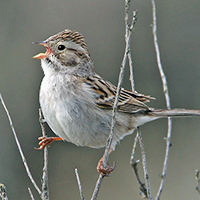
BirdNote®: Brewer’s Sparrow, Sageland Singer
/ Mary McCannView the page for this story
One of the most musical and complex bird songs in the US is that of the Brewer's Sparrow. It's a veritable aria, ringing out from the sagebrush of Eastern Washington's Columbia Basin. BirdNote®’s Mary McCann has more about this sageland singer. (01:59)
Show Credits and Funders
Show Transcript
HOST: Steve Curwood
GUESTS: Alfonso de Alba, Mark Dummett, Janet Redman
REPORTERS: Peter Dykstra, Andy Kubis, Mary McCann, Aynsley O’Neill
[THEME]
CURWOOD: From Public Radio International – this is Living On Earth.
[THEME]
CURWOOD: I’m Steve Curwood.
More than two thousand delegates from 185 countries are meeting in Germany to boost international climate ambition.
ESPINOSA: Reducing emissions sounds like a very technical concept. What does it really mean? It means less air pollution, which leads to improved health, especially for children, and it means the possibility of achieving our 1.5-degree goal.
CURWOOD: Also, Greenpeace USA has a climate scorecard for each presidential hopeful.
REDMAN: We need to be making sure that every candidate hears every day that climate change is on the top of the agenda, and we need to be demanding that the kinds of proposals and the kinds of promises that these candidates are making are commensurate with the challenge we’re facing. And then whoever gets elected has to be held accountable.
CURWOOD: That and more this week on Living on Earth – Stick Around!
[NEWSBREAK MUSIC: Boards Of Canada “Zoetrope” from “In A Beautiful Place Out In The Country” (Warp Records 2000)]
[THEME]
Increasing World Climate Ambition
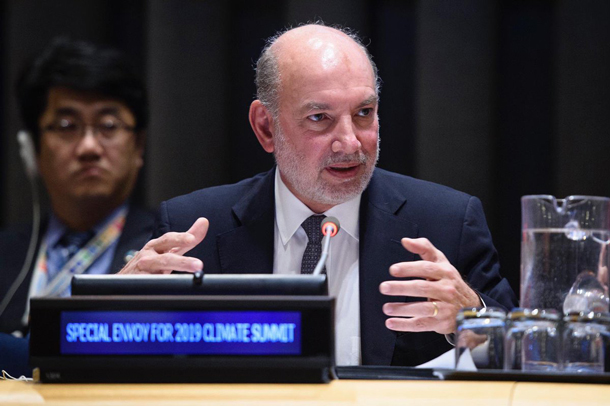
Luis Alfonso de Alba is the United Nations Secretary-General's Special Envoy on Climate Change. (Photo: Courtesy of Luis Alfonso de Alba on Twitter | @ladealba)
CURWOOD: From PRI and the Jennifer and Ted Stanley Studios at the University of Massachusetts Boston, this is Living on Earth. I’m Steve Curwood.
The United Nations is gearing up for a Climate Summit in New York in September, and already a number of nations have hinted they are boosting their nationally determined commitments or NDCs they first made under 2015’s landmark Paris Climate Agreement. Every country in the world is currently a signatory to Paris, and the hope is there will be enough action to keep the planet from warming more than 1.5 degrees Celsius. That’s a tough goal, considering Earth is already about 1.1 degrees warmer than pre-industrial levels. Still, more than 190 nations are expected to pledge more ambitious goals, though President Trump says he wants to take the US out of the Paris deal as soon as it becomes possible in November of 2020. Here to tell us more is Luis Alfonso de Alba, the United Nations Secretary General’s Special Envoy on Climate Change. Ambassador de Alba, welcome to Living on Earth!
DE ALBA: Thank you. Very nice to be with you, Steve.
CURWOOD: So just how many countries are saying that they're going to increase their ambition, increase their Paris Climate pledges, ahead of schedule?
DE ALBA: Well, this is a process that is evolving on a daily basis. For the time being, it's between 80 and 100 countries who have expressed the will to engage.
CURWOOD: Now, none of these countries, I gather, are making their intent public. When can we expect them to go public?
DE ALBA: Well, the first opportunity would be the summit itself, because they have been invited by the Secretary General to come within enhanced NDCs.
CURWOOD: So how important is this summit of world leaders in September, with regards to the climate?
DE ALBA: Well, I think it is a critical one, because as you know, the Paris Agreement has gathered the support of the international community and it has an ambitious agenda. But it needs to be sped up, the process of implementation, and scaled up. Because today, we know that we need to do much more, and much faster.
CURWOOD: If you look at the actual emissions from various countries, how far are we along in terms of commitments to reduce those emissions?
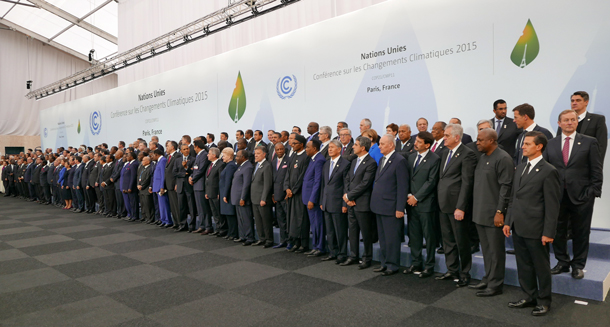
At the 2015 United Nations Climate Change Conference in Paris, heads of government and states from 185 countries reached an agreement on how to combat climate change. Now, countries under the Paris Accords are beginning to hint at plans to ramp up their pledges ahead of schedule. (Photo: Presidencia de la República Mexicana, Flickr, CC BY 2.0)
DE ALBA: If we take what governments have committed today, you will have about one third of what is needed to reduce emissions by 45% by 2030, and go to carbon neutrality by 2050. That's the goal. The emissions are very much concentrated on a small number of countries. And that's why one of the objectives of the summit is to target the G20 members, or the major emitters. We are also adding a few more countries that may become major emitters in the near future. And if you take those countries, you will have close to between 85 and 90% of global emissions.
CURWOOD: Now the Trump administration is looking to pull the United States out of its pledge under the Paris Accord at the same time. How would this affect the goals of the Paris Agreement?
DE ALBA: I think you need to take into account what the US is doing in general, and then the implications of pulling out of the Accord. I think the United States in general is doing a lot to fight climate change. And you can you can see that in a number of areas, and a number of commitments by the business sector, by local authorities in different parts of the States. And that contribution will continue to grow. And it's quite important, because the level of emissions of the US is one of the biggest. The pulling out of the Paris Agreement is a political decision the administration has taken. We certainly regret that decision, because we would like all countries to be fully involved into the process, and by being part of the process, give more strength to the Paris Agreement. But the Paris Agreement will continue, with the commitment of all the member states that have expressly committed. There was a possibility of some other countries stepping back. There were a few signals coming from Brazil, for instance. And they have recently recommitted to the Paris Agreement. And we are very pleased with that decision.
CURWOOD: What's your hope? That virtually all the countries, I guess, except in the United States at this point, will increase their pledges under the Paris Climate Agreement?
DE ALBA: I'm pretty sure that we will get there. The big question is not whether they will increase their ambition. I'm very optimistic about that. The question is that we need that very substantial increment in the ambition. So, we are looking not only on increasing the political will and the commitment of member states, but also to identify the areas on which innovation, on which the scaling up a number of initiatives could also help us speed up the process. We need to help member states to be able to increase substantially their NDCs. And that's part of, is the fundamental part of the Summit. It's not just an appeal to increase, but it is an opportunity to show the countries, the member states, how it can be done.
CURWOOD: And lastly, what would you see as success out of the Summit?
DE ALBA: Well, I think success would be certainly an increase on the level of ambition globally. I would see success in a process that will be constant, continuous, that will allow transitions, but at the same time will be constant, and will be including an increased number of sectors and areas on which we are working. I think success would be very much focused also in as much as governments understand that this is an issue that affects the economy as a whole. And not only the environment agenda.
CURWOOD: Luis Alfonso de Alba is the United Nations Secretary-General's Special Envoy on climate change. Ambassador, thank you so much for taking the time with us today.
DE ALBA: Oh, thank you. Thank you very much, Steve, it has been a pleasure to be with you.
Related links:
- New York Times | “United Nations Says 80 Countries May Ramp Up Climate Pledges”
- Find out more about the UN Climate Action Summit 2019
- United Nations | “The Task Ahead: Special Envoy de Alba Aims to Galvanize the World to Do More and Better”
Moving the Paris Climate Deal Ahead
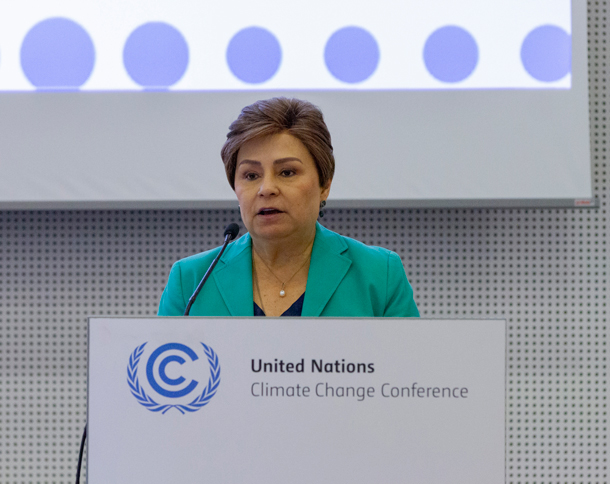
Patricia Espinosa is the Executive Secretary of the United Nations Framework Convention on Climate Change. (Photo: UNClimateChange, Flickr, CC BY-NC-SA 2.0)
CURWOOD: In advance of the New York Climate summit in September and the annual UN Climate Conference later this year, more 2,000 delegates representing 185 nations are now gathered in Bonn, Germany. This session was designed to advance rule-making under the Paris Climate Agreement. Paris is part of the overall international treaty on climate known as the United Nations Framework Convention on Climate Change or UNFCCC, a treaty the United States ratified during Clinton Administration. As Ambassador de Alba says, so far the reductions pledged by the nations of the world are too little to avoid what could become catastrophic climate disruptions, so the negotiators in Bonn are working to increase ambition. Living on Earth’s Aynsley O’Neill has more.
O’NEILL: To limit global warming to 1.5 degrees Celsius, the world must cut its carbon emissions dramatically. And many scientists and policymakers say we need to be a net-carbon-zero society by 2050. But it’s not just the future we need to think about.
Delegates heard there are huge public health and welfare benefits that can come from immediate cuts of emissions. Patricia Espinosa, Executive Secretary of the UN Climate treaty, offered an example from her home country of Mexico.
ESPINOSA: Reducing emissions sounds like a very technical concept. What does it really mean? It means, for instance, less air pollution, which leads to improved health, especially for children. I come from a country that has air pollution problems, and just last year, the schools needed to take the decision that children could not go out to play at any time during the day. They needed to stay inside because the air was so polluted. And there were a few days that schools didn’t even open. This is what reducing emissions means. It means also cleaner water. It also means more new, green jobs. And it means the possibility of achieving our 1.5-degree goal.
O’NEILL: The call for action is most urgent from the delegates whose countries are already feeling the direct effects of worsening natural disasters and rising seas. The cover for the June 24 issue of TIME magazine shows UN Secretary-General António Guterres knee-deep in the ocean off the coast of Tuvalu, a small Pacific Island country whose highest point is only about 15 feet above sea level.
The story itself focuses on the leaders of the most vulnerable island countries – Tuvalu, Fiji, the Bahamas – who are on the front lines of sea level rise. The developing nations have joined together to encourage the richest nations to increase their ambition under the Paris Agreement, since the fate of these poor, vulnerable countries is largely in the hands of the major carbon emitters in the world. Among those urging the delegates to act is Harjeet Singh, a representative of the nonprofit ActionAid. He’s from India, which has been plagued by crippling floods, and has just seen a deadly, month-long heat wave reaching temperatures of 123 degrees Fahrenheit. He says this isn’t just the recurring nightmare for some of those most at risk; this is their reality.
SINGH: The realities of the developed and developing worlds are very, very different. While developed countries are working towards climate-proofing their economy, or even exploring new sectors that climate change opens for them, but for developing countries and poor people, it's a fight for their survival. And that’s why we are here. That’s the reality that we are facing, and it’s just one degree of warming.
O’NEILL: Because the warming world is already disastrous for so many, it can seem like a losing battle against climate change. But there were some optimists in Bonn.
A session on emerging technology attracted a lot of attention, though some delegates are skeptical of waiting for technology to save the planet. And they say all the scientific solutions in the world won’t mean much if there isn’t the public and government support to implement them.
Still, some at the Bonn conference note there are emerging technologies that could be key components of an environmentally friendly future. For example, take the artificial intelligence behind self-driving cars, or smart grid systems, and apply it to agriculture. Real-time, smart monitoring of the carbon in soil could revolutionize farming to advance carbon sequestration, as well as provide food security. Martin Frick, the Senior Director of Policy and Programme Coordination at UNFCCC, shared a message of the hope that advancements could bring.
FRICK: That's actually reason for optimism, and I think optimism is exactly with what we need in this situation. We are bombarded with bad news, but we must not forget that on the other side, we have unprecedented possibilities, and we need to harness them.
O’NEILL: It’s unclear how far this session in Bonn will advance the specifics of the Paris Agreement, but the optimists among the delegates say that each step, no matter how small, can bring us closer to a solution.
For Living on Earth, I’m Aynsley O’Neill.
Related link:
See more from the June 2019 Bonn Climate Change Conference here
[MUSIC: Snarky Puppy “Shofukan” on the live DVD “We Like it Here”, GroundUP Music.]
CURWOOD: Coming up – A climate change scorecard for the field of presidential hopefuls. That’s just ahead on Living on Earth.
ANNOUNCER: Support for Living on Earth comes from Sailors for the Sea and Oceana. Helping boaters race clean, sail green and protect the seas they love. More information at sailorsforthesea.org.
[CUTAWAY MUSIC: Snarky Puppy “Shofukan” on the live DVD “We Like it Here”, GroundUP Music.]
Beyond the Headlines
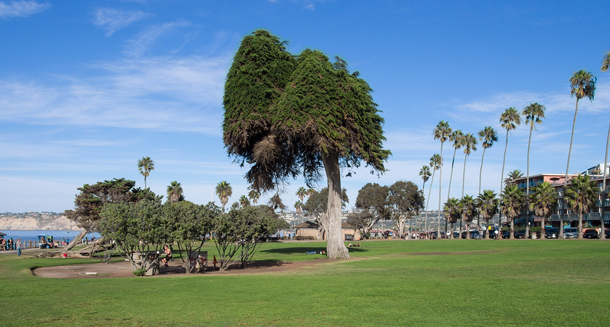
This Monterey cypress in San Diego, California’s Scripps Park, rumored to have inspired Dr. Seuss's Truffula trees in “The Lorax”, toppled over in June 2019 at an estimated 80-100 years of age. (Photo: Rhododendrites, Wikimedia Commons CC BY-SA 4.0)
CURWOOD: It's Living on Earth, I'm Steve Curwood. And it's time now to take a look beyond the headlines with Peter Dykstra. Peter's an editor with Environmental Health News, that's EHN.org, and DailyClimate.org, on the line now from Atlanta, Georgia. Hey, Peter, what's going on?
DYKSTRA: Hi, Steve. We're going to start with some sad news from the world of animation and books and movies. The Monterey cypress tree that's said to have inspired Dr. Seuss to write The Lorax has passed away, estimated age 80 to 100 years.
CURWOOD: Oh, no, not a Truffula tree! Where was it?

The titular character of Dr. Seuss' The Lorax is said to "speak for the trees". (Photo: Alan Parkinson, Flickr, CC BY-NC 2.0)
DYKSTRA: It was in a city park in San Diego, where Dr. Theodor Seuss Geisel could see it from his home. The city parks department hopes to repurpose the tree trunk, and of course, there's no word on the condition of The Lorax.
CURWOOD: Hmm. So “repurpose…” Maybe they'll make it into a chair or table, say, a table where they could lay out plans to address the threatened extinction of Monterey Cypress trees.
DYKSTRA: Ah, you're speaking for the trees, Steve, but we'll have to table that for now.
CURWOOD: Hey, what else do you have for us?
DYKSTRA: Another story caught my eye from Europe. The European far right, like a lot of far right political entities, including in this country, tends to be associated with climate denial. But there are the beginnings of a switch in Europe. Of course, the far right has enjoyed a rebirth in Europe, largely over fears – some of them quite hateful – about immigration. And of course, it's dawned on the far right in Europe that immigration is one of the consequences of climate change. So, they're taking another look at it in countries like Denmark.
CURWOOD: So, Peter, how far do you think this thing is going? Of course, in Europe, they have a multi-party system. So even just a few votes along these lines, if the far right and the far left get together, they might be able to do something.
DYKSTRA: They might have an impact in this one issue. Heaven knows what their impact would be on other issues. It's just significant that at the opposite end of the political spectrum, climate change may be starting to hit home.
CURWOOD: Well, funny thing about climate change, it doesn't discriminate. We're just one species and we have just one planet.
DYKSTRA: That's right. And it doesn't stop at the border or the coastline, even if the coastline is moving in a little bit.
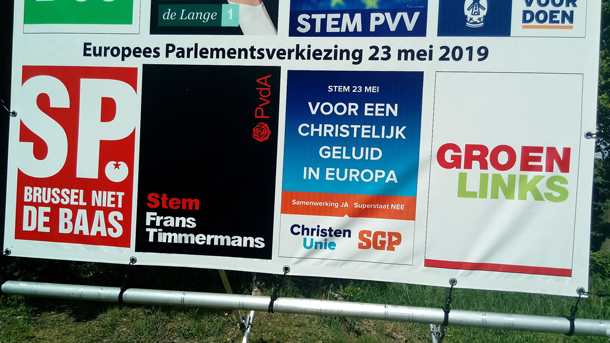
Election posters for the 2019 European Parliamentary elections. Far-right political parties in Europe’s multi-party system are reconsidering their previous climate denial stance because of a growing realization that climate disruption propels migration. (Photo: Donald Trung Quoc Don, Wikimedia Commons CC BY-SA 4.0)
CURWOOD: Hey, what do you have for us from the history vaults this week?
DYKSTRA: From the month of June in the year 1921, when the US Commerce Department convened what may well have been the first conference on water pollution. There were Feds, state and local officials, other stakeholders. They gathered not just to talk trash, but to talk about sewage and chemical waste, and everything else we dumped in our rivers back then, and to a lesser extent still dump in our rivers now.
CURWOOD: But, 1921… what happened as a result of this meeting?
DYKSTRA: Not much happened at all until the Cuyahoga River conspicuously caught fire and burned, 50 years ago this week. It wasn't the first time the Cuyahoga burned, but it was one that caught America's attention and inspired the Clean Water Act.
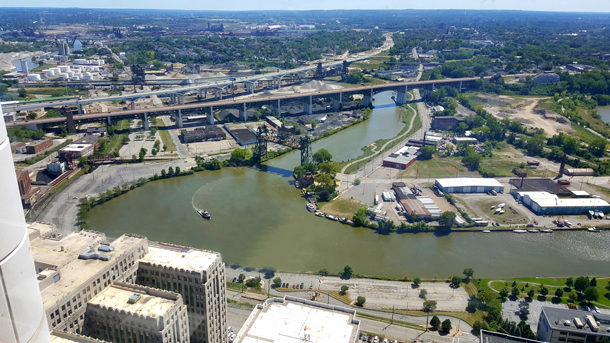
The polluted Cuyahoga River caught fire in Cleveland, Ohio 50 years ago, and helped catalyze the passage of the Clean Water Act. (Photo: Tim Evanson, Flickr CC BY-SA 2.0)
CURWOOD: Thank you, Peter. Peter Dykstra is an editor with Environmental Health News, that's EHN.org and DailyClimate.org. We'll talk to you again real soon.
DYKSTRA: All right, Steve, thanks a lot. Talk to you soon.
CURWOOD: And there's more on these stories at our website, LOE.org.
Related links:
- CNN | “The tree thought to have inspired Dr. Seuss’s ‘The Lorax’ has fallen”
- Dissent Magazine | “The European Far Right’s Environmental Turn”
- Learn more about U.S. water policy in the early 20th century
[MUSIC: Roy Hargrove Quintet, “Top Of My Head” live studio session, KNKX Studios.]
Bringing Back Butternut Trees
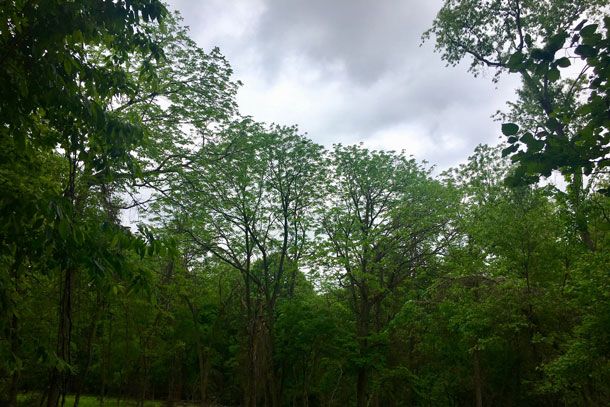
A stand of healthy butternut trees, untouched by canker fungi. (Photo: Andy Kubis)
CURWOOD: Butternut trees are sometimes called white walnut trees, and yes, their nuts are delicious. They are common across the eastern US, but now they are threatened by a deadly fungal disease. In some areas, it can be hard to find one that’s not already affected. And that is why ecologists at the Pittsburgh Parks Conservancy were so excited by a discovery in a local park. From the Allegheny Front, Andy Kubis has our story.
KUBIS: The forest behind the Frick Environmental Center is lush. But walk about 500 feet along the Clayton Hill trail and you come to a clearing.
JUDITH: It looks a little bit shocking when you first see it ... every open space you see there used to be a tree.
JUDITH: This is Judith Cook. She coordinates volunteer landscape projects for the Pittsburgh Parks Conservancy. Cook worked on a restoration project in this area of the park all winter. The original plan was to get rid of a giant stand of invasive honeysuckle that had taken over.
JUDITH: This whole area, you couldn't see anything. It was just really a wall of honeysuckle. It was so crazy.
KUBIS: The honeysuckle in this patch of forest likely escaped from someone’s yard and had been growing, unchecked, for about two decades. But once it was cleared, the parks staff found a pleasant surprise: ten strong, full-grown butternut trees. Cook stands in the clearing and points up to one.
JUDITH: So, here’s a perfectly healthy butternut, that I’ve never really seen before in Pittsburgh parks. Growing perfectly fine in our woodlands, the way they’re supposed to.
KUBIS: You rarely find a healthy butternut because of a deadly, exotic fungus that causes a fatal disease called butternut canker. In some states, 80% of the butternuts have already died.
The trees, also known as white walnuts, used to be widespread in Pennsylvania’s forests, and their nuts are an important food source for wildlife. When a butternut gets canker, it develops an oblong-shaped abscess that oozes. The wounds eventually cut off the tree’s nutrient supply, and it dies. According to the Parks Conservancy, every butternut in Frick Park shows symptoms of the disease, except for these newly uncovered ones. That’s why it’s such an important discovery.
JUDITH: There are just so many threats to our native trees that seeing trees that are not diseased, that are withstanding something that is spreading throughout the country and taking out entire species – that is a big deal to us. I’m not sure if it’s such a big deal to the public though.
KUBIS: What’s your best guess for why these don’t have canker?
JUDITH: We don't really know why they don’t have canker. The reason why we’re interested in them is we are interested in their genetic makeup. We want to see if they are maybe not susceptible to the canker or just a little bit stronger than other butternuts.
KUBIS: The healthy butternuts will be closely monitored for the next couple years for any signs of the fungus. If they remain canker-free, parks staff will collect their DNA and add it to a genetic database of the city’s strongest trees. And they’ll also grow new trees that will be used to re-populate this site. For now, the hard work of forest restoration continues.
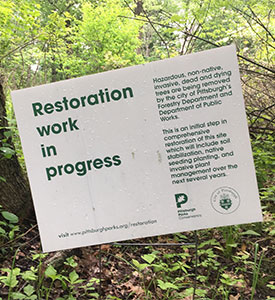
Restoration of these native trees led to the discovery of 10 healthy trees within Frick Park. (Photo: Andy Kubis)
[Chainsaw Sounds]
KUBIS: Today, there’s a chainsaw to help. But often it’s just a lot of old-fashioned hand-weeding to keep the site free of invasives – like that pesky honeysuckle that is already trying to creep back.
KUBIS: What's next here? What are you going to be looking for and what are you going to be doing?
JUDITH: We will continue going out here with interns and with volunteers and with staff and removing as many invasives as we can as they are re-growing, so ideally in two to three years we can start planting restoration trees on the site to start filling in the canopy.
KUBIS: Cook says the project will take at least 10 years. But when they’re done, the tree canopy will be closed – they hope – by a bunch of healthy, canker-free butternut trees.
JUDITH: That is like one of the greatest things about Pittsburgh, that we are so green. And we have so many parks. So, it's really important to preserve them and make them stronger
CURWOOD: That story from Andy Kubis comes to us courtesy of the Allegheny Front.
Related link:
Read this story on the Allegheny Front’s website
[MUSIC: Shakey Graves, “Built to Roam” Audio Tree Live]
Rating the Climate Promises of 2020 Prexy Candidates
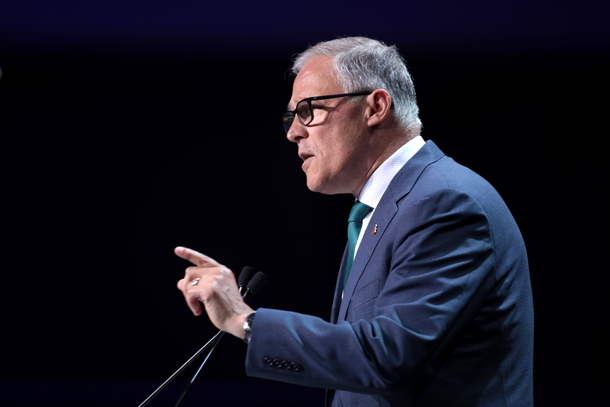
Demoratic Presidential hopeful and Washington Governor Jay Inslee fared best on Greenpeace’s climate scorecard, but still didn’t make a perfect grade: he received an A-. The organization says all the 2020 presidential candidates have room for improvements in terms of their climate commitments. (Photo: Gage Skidmore, Wikimedia Commons, Gage Skidmore from Peoria, AZ, United States of America, CC BY-SA 2.0)
CURWOOD: Climate change was barely mentioned during the 2016 presidential election but this time around many Democratic presidential contenders are pledging climate action. But with over twenty Democratic candidates it can be hard to keep track of where they each stand on the climate crisis. So, to sort it all out, Greenpeace USA put together a climate scorecard, grading each candidate on his or her support for a Green New Deal and to phasing out fossil fuels. Here now is Janet Redman, Climate Campaign Director for Greenpeace USA, on the line from Washington, DC—hi, Janet, welcome to Living on Earth!
REDMAN: Thanks so much for having me. It's a pleasure to be with you.
CURWOOD: So, Janet, you took all these candidates and graded them based on their climate rhetoric. Tell us about the criteria you used—what did you use?
REDMAN: Certainly, we started with two big sets of criteria. We're looking at each candidate's support of the Green New Deal, and each candidate's support of phasing out fossil fuels. The Green New Deal, of course, is an ambitious plan that's looking at how to move to 100% renewable energy in a way that's just and fair, both for workers and communities. So, it's really about tackling the climate crisis, but making sure we're tackling economic crises and other injustices is at the same time. So the kinds of criteria we've got, and there about seven or eight criteria, are around getting to net zero greenhouse gas emissions, supporting the Paris Agreement, looking at labor protections, really understanding what candidates are saying about climate resiliency and their commitments to moving towards zero emissions in the transport sector, power sector, building sector, industrial sector, etc.
CURWOOD: And what about the other category?
REDMAN: The other category that I think is really exciting and is less talked about, is about phasing out the fossil fuel industry. And that's really the complement to the Green New Deal. Phasing out fossil fuels is about dialing down the dirty energy we already have under production right now and making sure we're not expanding into new dirty energy. So, that is looking at whether or not candidates have committed to a responsible and managed phase out of fossil fuels over time, whether they've committed to ending fossil fuel leasing on public lands, ending subsidies, taxpayer subsidies to oil and gas, banning oil and gas exports. Really thinking about polluter accountability and environmental justice for those communities who are already impacted by production. A key piece that we're asking every single candidate to do, and doing this in coalition with many, many environmental groups, is to ask every single candidate to take a pledge not to take any money from the fossil fuel industry. It's called the no-fossil-fuel-money pledge. We've got, I think now, 18 out of the leading Democratic presidential candidates have taken this pledge. But that's one of the markers that we're also looking at in terms of grading these candidates.
CURWOOD: So, one of the things that happened as coal wound down was communities were just simply left high and dry. What about that aspect of the workers who'll be left behind if you phase out fossil fuels?
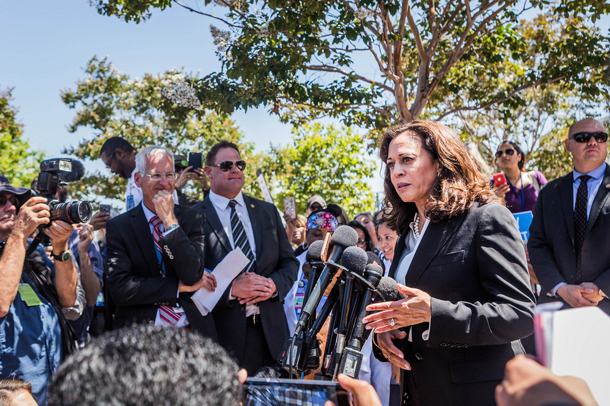
Some candidates, like Kamala Harris, had not yet responded to Greenpeace’s climate questionnaire as of June 18 and have not yet released a comprehensive climate plan, making it difficult to evaluate their commitment to address the climate crisis if elected to the White House. (Photo: Office of Senator Kamala Harris, Wikimedia Commons, Public Domain)
REDMAN: That's exactly why we need a responsible phase out. We will have a transition away from dirty energy, I firmly believe that, because we're seeing so many impacts of climate change right now. And because frankly, renewable energy costs less than dirty energy. We already saw that with the coal industry. So what happened with the transition in the coal industry is that that was an unmanaged transition. So the transition plan was: coal companies go bankrupt and they leave communities and workers high and dry. They've broken their promises to make sure that coal miners have their pensions as they get older, they've broken their promises to fund funds for making sure that miners with black lung have their health costs paid for, they've broken their promises to communities that there would be an economic development transition. So what we don't want to see happen is an unmanaged, irresponsible transition away from oil and gas. We want to make sure that we're putting plans in place now to responsibly phase that down over time. No one's talking about pulling the plug on all of the fossil fuel electricity generation, for example, right this second. What we're talking about is making sure, number one, we're not building new oil wells, we're not building new oil rigs, we're not going out and exploring for new oil and gas. That's the first step. And then number two, let's put a plan in place with the full weight of the federal government behind us to make sure that we are, in fact, phasing out of these fossil fuels in the way that is most responsible to people working in the industry, and responsible to all the communities who depend right now on the fossil fuel industry as part of their tax base, as part of their jobs base. We can do this; it just takes actual planning.
CURWOOD: So, those were the criteria that you used to look at the candidates for president. But how did you figure out their grades?
REDMAN: First and foremost, we sent a survey to every single campaign office and asked for detailed answers to all of our more than 21 questions. We received about five or six of those back before we published the scorecard. And for everyone else, including the folks that responded to the survey, we looked at the public record. And that meant looking at, certainly, candidates’ voting records, looking at public statements that had been made, looking at existing climate platforms that candidates had put forward. What's really important, though, we intentionally weighted really forward-looking commitments at this point in time. First of all, because not every single candidate has been a part of the Senate or the House. But I think, even more importantly, because what we're talking about right now is, in the early days of the election season, is really setting the level of ambition amongst candidates on climate change. We're really pushing to make sure that all these candidates understand that the American public is not just interested in climate change as an issue, but feels incredibly strongly that we need the next president to address both a Green New Deal and a fossil fuel phase out. So, we were particularly looking for climate plans that candidates had put forward making ambitious statements, setting ambitious targets for action.
CURWOOD: So, you said you sent surveys to the presidential candidates and you only got five, was it six, back? Which ones responded?
REDMAN: Certainly, we got responses back from Senator Booker, Tulsi Gabbard, Kirsten Gillibrand, Governor Inslee, Senator Warren's office, all responded back to our survey.
CURWOOD: Okay, time now to see the envelopes opened. Which candidates came out on top?
REDMAN: Right now, Governor Inslee has the highest score in our scorecard with an A minus. I should note that all of the scores are relatively low. We, again, set a range of 100 points and the idea is that to get 100 points, you really need to make some bold, ambitious statements and have some really concrete plans about how to address the climate crisis in a manner that is commensurate with the challenge we're facing. So, at 80 points Inslee comes in with an A minus. He has articulated multiple pieces of a climate plan and released those, he addresses the fossil fuel phase out. And also, of course, has come out in favor of the Green New Deal.
CURWOOD: So, Janet, which candidates have some room for improvement?
REDMAN: Well, every candidate, of course, has tons of room for improvement. Maybe I'll talk about Vice President Biden quickly. In our original scoring, he received a D minus. He didn't have a climate plan. He hasn't said much about climate change in his campaign so far. But after our scoring, a couple days after our scorecard originally was released, he did release, his campaign did release, a climate plan, which was much broader than we thought it would be. Frankly, we were pleasantly surprised. He actually has moved up to a B, which is exciting. And those places where he has room for improvement, there are things like taking the no-fossil-fuel-money pledge, which just about every other frontrunner has done so far in the Democratic field, that he could take those actions immediately and up his grade some more. There are other folks like Kamala Harris, who is an exciting candidate, but has not taken the survey and has not released a climate plan to date. So, she just doesn't get much of a score because there's not much to score her against. So, we're really looking forward to a number of candidates releasing their climate plans and a number of candidates refining what they've talked about in terms of climate commitments, so we can really judge them against each other and understand what exactly they would stand for if they were in the White House in a couple of years.
CURWOOD: Let's quickly walk through the top of your list.
REDMAN: Sure. At the top of our list is Governor Inslee, A minus; Senator Booker, A minus; Senator Sanders with a B plus; Senator Warren with a B plus. Next is Gillibrand with a B; Tulsi Gabbard with a B; Vice President Biden with a B; and Marianne Williamson, also with a B. Following them is O'Rourke with a B minus.
CURWOOD: And then who's in the C territory?
REDMAN: So, following behind the frontrunners, we've got Pete Buttigieg, Senator Harris both having C's; Swalwell, Delaney, Klobuchar in C minuses. We've got Castro and Yang and Tim Ryan with a D plus. And then Bullock and Hickenlooper with D, D minus. Most of those lower grades are because those candidates have either not released a plan on climate change at all, or actually said things that we think are really counter to climate action, for example, saying that gas is a bridge fuel, when we know it's actually a fossil fuel that makes climate change even worse.
CURWOOD: And where are the Republicans on your list?
REDMAN: Well, right now, of course, there are only two Republican candidates: Trump, who's running and has the RNC's backing; and Weld, both of which have F's. Trump has a hot zero, which is not surprising given what he's done so far in office, including rolling back environmental regulations and health protections, committing to expanding oil and gas drilling off our coasts and in our public lands, and really has been promoting this "energy dominance" agenda, which means expanding fossil fuels and ignoring the climate crisis at a time when we really need to be taking action.
CURWOOD: And Governor Weld?
REDMAN: Governor Weld has a seven. He has said important things about going to net zero greenhouse gas emissions and supports going back to the Paris Agreement. But besides that, has said little else.
CURWOOD: So as far as Greenpeace is concerned, both Republicans are seriously flunking.
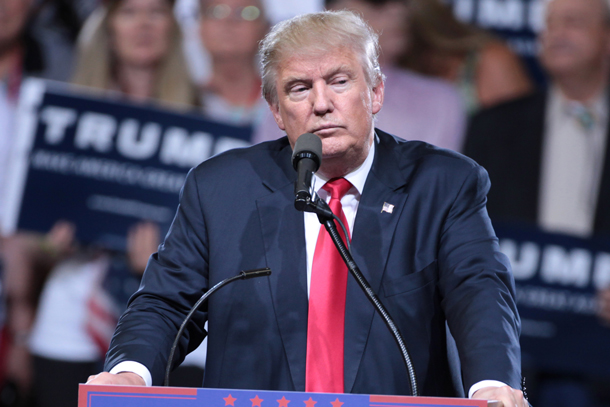
Trump came in last place on Greenpeace’s scorecard, receiving a “hot zero” for his ongoing hostility towards environmental regulations, his eagerness to open American shorelines and public lands to fossil fuel exploration, and his open denigration of climate science. (Photo: Gage Skidmore, Wikimedia Commons, CC BY-SA 2.0)
REDMAN: They're seriously flunking. When we look at room for improvement, there is massive room for improvement right now in the Republican candidate field. And we would like to see improvement there as well. This is really not a Democrat or Republican issue. This is an issue that impacts every single person across the United States already today, and of course, is a critical geopolitical issue that any next president will have to deal with on the global stage.
CURWOOD: Janet, how optimistic are you that this cycle of presidential elections will result in firm action on climate? As Bill McKibben is famous for saying, we've had a bipartisan deal to not really do much on climate. Even President Obama, for example, couldn't quite get the regulations to deal with the Clean Power Plan on the books.
REDMAN: I'm very optimistic. I think the answer to whether or not we'll see the next president talk about climate change and do what needs to be done on climate change is really up to us. We need to be making sure that every candidate hears every single day that climate change is on the top of the agenda, and we need to be demanding that the kinds of proposals and the kinds of promises that these candidates are making are strong, are bold, are inspiring, are frankly, commensurate with the challenge we're facing. And then whoever gets elected has to be held accountable. I think the climate movement was a little easy on Obama in the first years of his presidency, and that probably allowed him to slip on climate action. So, whoever's in the White House next, people across the United States who are impacted by climate change need to hold the next president accountable. And that's a big part of what Greenpeace is committed to doing, and certainly working with allies across the country to make sure whoever's in the White House next has the political space and the political pressure to act on climate fast and furiously.
CURWOOD: Janet Redman is Climate Campaign Director for Greenpeace USA. Thanks so much for taking the time with us today.
REDMAN: Great to be with you. Thanks very much.
Related links:
- Greenpeace USA’s 2020 Candidate Climate Scorecard
- Mother Jones | “Greenpeace Graded All the Presidential Candidates’ Climate Policies. They Weren’t Impressed.”
- Business Insider | “None of the Democratic candidates even come close on climate change to where voters want them to be”
MUSIC: Tommy Emanuel, “Angelina” on Endless Road]
CURWOOD: Coming up – Seeking justice for a lethal legacy of oil extraction.
That’s just ahead on Living on Earth.
ANNOUNCER: Funding for Living on Earth comes from you, our listeners, and United Technologies, combining passion for science with engineering to create solutions designed for sustainability in aerospace, building industries, and food refrigeration. UTC companies such as Otis, Carrier, Pratt and Whitney, and UTC Aerospace systems are helping to move the world forward. You can learn more about United Technologies by tuning into the Race to Nine Billion podcast; listen at racetoninebillion.com. This is PRI, Public Radio International.
[CUTAWAY MUSIC: Tommy Emanuel, “Angelina” on Endless Road]
Seeking Justice for the Ogoni Nine
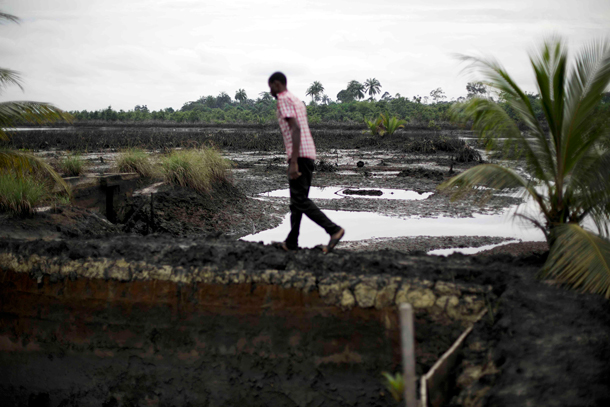
Widespread reports of environmental and economic damage to the Niger River Delta caused by the activities of Royal Dutch Shell have angered activists since the 1990s. (Photo: Kegbara- dere community oil spill, Ogoniland, Nigeria, Luka Tomac/Friends of the Earth International, Flickr, CC BY-SA 2.0)
CURWOOD: It’s Living on Earth, I’m Steve Curwood.
This May, Esther Kiobel came one step closer to justice in her battle against The Royal Dutch Shell Oil Company. She has pursued the oil giant for nearly 25 years, since the Nigerian government executed her husband in 1995 on trumped up charges, allegedly encouraged by Shell. Ms. Kiobel’s husband was part of a group known as the Ogoni Nine, activists who fought against Shell for environmental and economic damages to their homeland near the Niger River Delta. The Ogoni Nine were eventually detained, tried under suspicious circumstances, and sentenced to death, prompting global condemnation. Amnesty International has been involved since the early days of the case, and the organization is now supporting Ms. Kiobel’s second attempt to seek reparations from Shell for allegedly colluding with the Nigerian government to execute her husband. On May 5, the District Court of The Hague announced it would hear Ms. Kiobel’s case in the Netherlands. Mark Dummett is Head of Business and Human Rights for Amnesty International, and has been following the case since 2014. He joins us now from London. Hi Mark, welcome to Living on Earth.
DUMMETT: Hi there, thank you so much for having me.
CURWOOD: Our pleasure. Now, Amnesty International has been involved with the Ogoni Nine since the 90s and up until now with this new lawsuit. Quickly, just set the scene for me. What happened in Nigeria with the Ogoni Nine?
DUMMETT: So, the Ogoni Nine come from the southeast of Nigeria, an area called the Niger Delta, which is Africa's most valuable oil-producing region. Unfortunately for them, it has also become a scene of widespread environmental devastation caused by massive amounts of oil pollution. And that's because there are all these oil fields scattered across this whole area connected by pipelines, which have generally been poorly maintained. So, every year there are hundreds of spills. And it's had an appalling impact on the people living there. And now the Ogoni Nine were amongst a group of protesters from the Ogoni community who started a popular movement against Shell and the Nigerian government, against the pollution and also against the unfair distribution of oil wealth. Because they saw all the money that was coming from this oil going to other parts of the country, and to foreigners in the form of these big oil corporations.
CURWOOD: Now, of course, there was a protest movement led by Ken Saro-Wiwa and some eight other folks involved, the Ogoni Nine. What happened to Ken Saro-Wiwa and the others?
DUMMETT: Yeah, so in response to this protest movement, the Nigerian military launched a really brutal crackdown on the Ogoni region, on their villages, and arrested lots of people. Lots of women and girls were raped, people were shot, killed, prisoners were tortured. And then, in the midst of this, they accused Ken Saro-Wiwa, who was the leader of the movement, and a number of his supporters, of involvement in the brutal murder of four chiefs who were opposed to the protest movement. And on the basis of very flimsy evidence, they found Ken Saro-Wiwa and eight others guilty of this brutal murder or involvement in this brutal murder, and then executed them. And really, this then goes back to Amnesty's first involvement in this issue and in the Niger Delta. We came out, along with human rights organizations and activists around the world, to condemn this completely unfair trial and these executions of innocent men.

In 1995, Ken Saro-Wiwa and eight other men, known collectively as the Ogoni Nine, were executed by the Nigerian government. The Ogoni Nine had helped lead a protest movement against Royal Dutch Shell and the environmental degradation caused by the company’s oil exploration in their homeland. (Photo: Kegbara- dere, reflection in oil polluted river, Luka Tomac/Friends of the Earth International, Flickr, CC BY-SA 2.0)
CURWOOD: Now, when it came to the trial of the Ogoni Nine, what was unfair about this trial? And how did the world respond to this trial?
DUMMETT: So, there were a number of ways in which the trial was a sham. To begin with, the men were arrested and held without being allowed to see their lawyers for many months. And then the evidence that was used to prosecute these men was based on the testimony of prosecution witnesses, of a number of witnesses, two of whom later recanted and said that they had been bribed by the Nigerian government and Shell to say that Ken Saro-Wiwa and the other men had been responsible for this murder that they were falsely accused of.
CURWOOD: So, what about Amnesty's concern that Shell was complicit in this unfair trial and the human rights violations? Shell says, "No, no, no," they deny all these allegations against it. So briefly, what is the evidence against Royal Dutch Shell in this case?
DUMMETT: So, we've seen hundreds of documents and hundreds of pages of court depositions which point to an incredibly close relationship between Shell and the Nigerian government at all levels. And they operated as business partners. They had a shared interest in ending these protests. And we know that they shared information about the protests. We know that Shell had its own surveillance operation and that these operatives had received training from Nigeria's Internal Security Agency, which itself was responsible directly for a number of human rights violations, such as arbitrary killings, rape, destruction of property, burning of homes, for example. Not just crimes under international law or human rights violations, but they were also crimes under domestic law. So, it's possible to be involved in a crime and not, you know, be in the room when it happens. We're not alleging that any evidence exists for individuals working for Shell at the time to be in the room when protesters were being tortured. But what we are saying is that Shell played a key role in those crimes occurring through encouraging, through soliciting, providing the tools by which these crimes were then carried out by the Nigerian state.
CURWOOD: And Shell today still denies involvement in this business, I gather.
DUMMETT: Shell says that, well, firstly, it's not its place—it's not the place of any corporation to intervene in the internal matters of a sovereign state. And secondly, they say that when it became clear that the men were facing execution, the company sent a letter to President Sani Abacha calling for him to show leniency and prevent these executions, or not go ahead with the executions. But Shell's own records of meetings show that Shell actually never raised concerns about possible executions or any other human rights violations that they knew the military was behind. Now, Shell has released a copy of the letter that the company says was sent to Sani Abacha, but we have no evidence whether it was actually sent or received, and certainly by the time it was sent, it was, it was probably too late to make a difference because it was sent just, you know, shortly before the executions were carried out and not in the many weeks or months beforehand.
CURWOOD: Now, these allegations point to horrible civil rights violations, human rights violations. But there's another casualty one might see here, and that's the environment itself. How does the environment play into all of this?
DUMMETT: The damage that's been done to the environment from, you know, early in the days of oil production in Nigeria through to today is hugely, hugely important, really, to understanding the protests. It really now defines the Niger Delta, you know, the appalling impact on people's lives, on their livelihoods. You know, one of the reasons why Ken Saro-Wiwa was successful in mobilizing protests, he was able to catch the attention of environmentalists around the world and human rights activists around the world, is because he articulated very well how environmental problems are also human rights problems and social justice problems. So, you have these poor communities that are relying on fishing and farming. And then all of a sudden, an oil field is discovered on their land or in their waterways. What's happened since then is that their waterways where they fish and the fields where they, where they farm, and the forests where they go and hunt, have been polluted. So, they've lost out there. But then the money that comes from the oil disappears and they don't benefit from that, either. So, you can't look at this just as an environmental problem or as a social justice or human rights problem. But it's, it's intertwined. It's all connected.
CURWOOD: Is a short description "disaster?"
DUMMETT: It is a disaster. Yeah. Yeah, very, very much so. And it's one that continues to this day. I mean, last year, we did more research on Shell's current operations in Nigeria. You know, the fact is, there are still dozens and dozens of spills every year. And we believe there's strong evidence that Shell is still not maintaining its pipelines properly.
CURWOOD: So, after the Ogoni Nine were killed, Ken Saro-Wiwa and the eight others with him, what happened to their families? What happened to their spouses?
DUMMETT: Well, I think it's fair to say that their suffering didn't end just with the deaths of their husbands. I know at least two of them, Esther Kiobel and Victoria Bera, were forced to flee Nigeria as refugees, along with many other Ogonis and many other people who had been involved in the protests. Esther, whose husband Barinem Kiobel was a government official who was executed—one of the Ogoni Nine—then came to the United States as a refugee. And Victoria, whose husband Baribor Bera was also executed, was accepted as refugee in Canada. At least two of the other women who I'm in touch with have stayed in Nigeria. But I think for all of them, they've faced a very difficult time because not only did they have to deal with the loss of their husbands and their husbands' incomes, but also faced harassment and threats from opponents of Ken Saro-Wiwa, including some of the prosecution witnesses.
CURWOOD: So, Esther and Victoria have brought this litigation, what do you think it would mean for these widows to win in court?
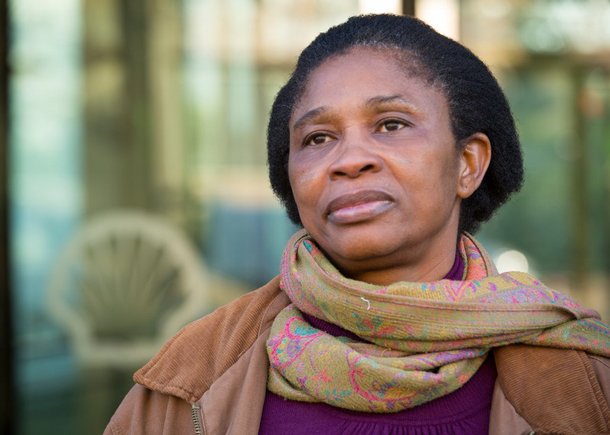
Esther Kiobel is suing Royal Dutch Shell for the oil giant’s alleged complicity in the murder of her husband and the eight other Nigerian activists collectively known as the Ogoni Nine. Since fleeing Nigeria to the United States, Esther Kiobel has sought justice for nearly 25 years. This May, a District Court in the Netherlands agreed it would hear her case for reparations and the clearing of her husband’s name. (Photo: Esther Kiobel, courtesy of Amnesty International)
DUMMETT: I think it would be hugely important. I do know them, and to them, it seems like their husbands were just executed yesterday. Their emotion is very raw and they are suffering hugely from the injustice to this day. They're still on the books in Nigeria as criminals, and it hurts them that it's taken this long for them to get any kind of hearing in a court.
CURWOOD: What are they looking for here? What would they like the court to order for them at the end of the trial?
DUMMETT: I mean, it's a civil case. So, they're asking for compensation. But they've made it very, very clear that for them, their primary goal is to get justice, to get a recognition that their husbands are innocent. And they're calling specifically for a public apology from Shell. And Esther has said that she wouldn't be interested in a settlement, for example. It's a battle for justice and recognition for the injustice that was done in 1995 and continues to be done every day. You know, it is going to be undoubtedly very difficult. One of the real challenges is that, you know, most of the evidence is kept within Shell itself. I mean, you know, the sort of evidence would include lots of documents. But it's difficult to persuade the courts, in general, to force companies to release all of that sort of information. So, there's a huge power imbalance between the two sides, the companies on the one hand, which retain the evidence, and then on the other hand, you know, the victims.
CURWOOD: So, what would be the message to the world should these women prevail against Shell?
DUMMETT: Well, I think there would be several different messages, one of those would be just how brave and persistent these women have been to continue to fight for justice. And I think that would be a message of hope to activists and victims of human rights violations around the world. I think the other message would be to the companies themselves. Not just Shell, but you know, multinational corporations wherever they operate in the world, wherever they're based. You know, we know in this globalized world that companies operate across boundaries. And that's one of the reasons why they were able to escape justice, because justice systems haven't quite caught up with that and find it hard to hold companies to account for any kind of negative harm from their operations, and indeed from their business models. So courts are an avenue for climate activists, as much as they are for, you know, Amnesty International and Victoria and Esther. If this case goes in Esther and Victoria's favor, then this will be a precedent for a company being held accountable for operations that took place, you know, on another continent, and two decades ago, and I think that would be, you know, an incredibly powerful message.
CURWOOD: Mark Dummett is Head of Business and Human Rights at Amnesty International in London. Thank you so much for taking the time with us today.
DUMMETT: You're very welcome. Thank you.
CURWOOD: We contacted Royal Dutch Shell for statement about the allegations against them but they declined to comment on ongoing litigation
Related links:
- The Guardian | “Dutch Court Will Hear Widows’ Case Against Shell Over Deaths of Ogoni Nine”
- Amnesty International | “Nigeria/Netherlands: Shell Involvement in Execution of Ogoni Nine to Be Decided by Court”
- Amnesty International’s independent report of Shell’s involvement in human rights violations in Nigeria in the 1990s
BirdNote®: Brewer’s Sparrow, Sageland Singer
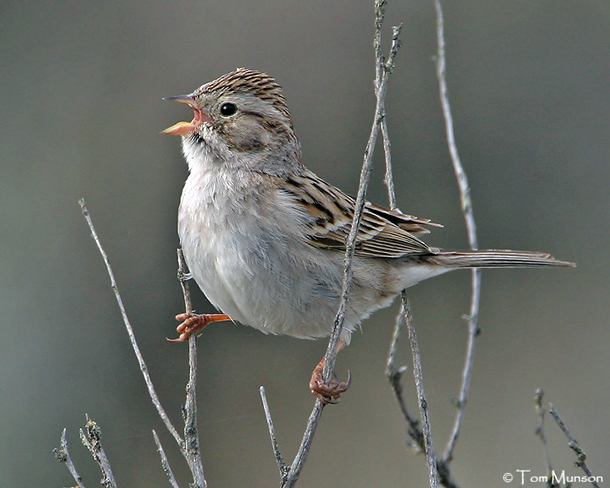
A Brewer’s Sparrow sings lustily in the American West. (Photo: © Tom Munson)
[BIRDNOTE THEME]
CURWOOD: In the wide-open spaces of the American West, a dusky brown bird holds forth with an impressive song. BirdNote®’s Mary McCann has more about the sage land singer called the Brewer’s Sparrow.
[Long song of the Brewer’s Sparrow]
MCCANN: Every spring, one of the most musical and complex bird songs on the continent rings forth from the sagebrush of the Columbia Basin in Washington State. The Brewer’s Sparrow, a migratory songbird that winters mostly in western Mexico, returns in April to the sage. Sagebrush habitat, often called shrub-steppe, is a common landscape of the interior West. However, each year more and more of it is being cleared for irrigated crops and development. The diminutive Brewer’s Sparrow shares its nesting habitat with other fancy singers like the long-winded Sage Thrasher and the melodic Vesper Sparrow. All three of these birds are sandy brown in color, blending so seamlessly with their surroundings that only a sharp eye can pick them out. Yet even among this accomplished company, the Brewer’s song stands apart. While most birds offer a melody, the Brewer’s Sparrow seems to perform an entire aria.
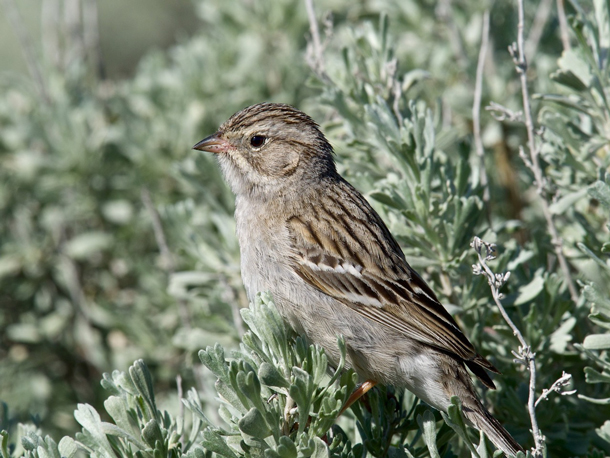
Brewer’s Sparrows thrive in sagebrush habitats. (Photo: © Gregg Thompson)
[Song of the Brewer’s Sparrow]
### Written by Bob Sundstrom
Song of the Brewer’s Sparrow provided by The Macaulay Library of Natural Sounds at the Cornell Lab of Ornithology, Ithaca, New York. Recorded by G.A. Keller.
BirdNote’s theme was composed and played by Nancy Rumbel and John Kessler.
Producer: John Kessler; Managing Producer: Jason Saul; Editor: Ashley Ahearn; Associate Producer: Ellen Blackstone; Assistant Producer: Mark Bramhill.
© 2019 Tune In to Nature.org June 2012/2019 Narrator: Mary McCann
ID# 060705BRSP BRSP-01b
https://www.birdnote.org/show/brewers-sparrow-sageland-singer
CURWOOD: For pictures, fly on over to our website, LOE.org.
Related links:
- Learn more on the BirdNote® website
- More information at BirdWeb.org
[MUSIC: Jacob Collier, “Hideaway” on In My Room]
CURWOOD: Living on Earth is produced by the World Media Foundation. Our crew includes Naomi Arenberg, Diego Arenas, Bobby Bascomb, Paloma Beltran, Thurston Briscoe, Jenni Doering, Don Lyman, Lizz Malloy, Aynsley O’Neill, Jake Rego, Joseph Winters, and Jolanda Omari. Tom Tiger engineered our show. Alison Lirish Dean composed our themes. You can hear us anytime at L-O-E dot org, iTunes and Google play- and like us, please, on our Facebook page - PRI’s Living on Earth. We tweet from @livingonearth. And you can find us on Instagram at @livingonearthradio. I’m Steve Curwood. Thanks for listening!
ANNOUNCER: Funding for Living on Earth comes from you, our listeners, and from the University of Massachusetts, Boston, in association with its School for the Environment, developing the next generation of environmental leaders. And from the Grantham Foundation for the protection of the environment, supporting strategic communications and collaboration in solving the world’s most pressing environmental problems. Support also comes from the Energy Foundation, serving the public interest by helping to build a strong, clean, energy economy.
ANNOUNCER 2: PRI, Public Radio International.
Living on Earth wants to hear from you!
Living on Earth
62 Calef Highway, Suite 212
Lee, NH 03861
Telephone: 617-287-4121
E-mail: comments@loe.org
Newsletter [Click here]
Donate to Living on Earth!
Living on Earth is an independent media program and relies entirely on contributions from listeners and institutions supporting public service. Please donate now to preserve an independent environmental voice.
NewsletterLiving on Earth offers a weekly delivery of the show's rundown to your mailbox. Sign up for our newsletter today!
 Sailors For The Sea: Be the change you want to sea.
Sailors For The Sea: Be the change you want to sea.
 The Grantham Foundation for the Protection of the Environment: Committed to protecting and improving the health of the global environment.
The Grantham Foundation for the Protection of the Environment: Committed to protecting and improving the health of the global environment.
 Contribute to Living on Earth and receive, as our gift to you, an archival print of one of Mark Seth Lender's extraordinary wildlife photographs. Follow the link to see Mark's current collection of photographs.
Contribute to Living on Earth and receive, as our gift to you, an archival print of one of Mark Seth Lender's extraordinary wildlife photographs. Follow the link to see Mark's current collection of photographs.
 Buy a signed copy of Mark Seth Lender's book Smeagull the Seagull & support Living on Earth
Buy a signed copy of Mark Seth Lender's book Smeagull the Seagull & support Living on Earth

